Operator(s) Metro (LACMTA) | Status Partially complete | |
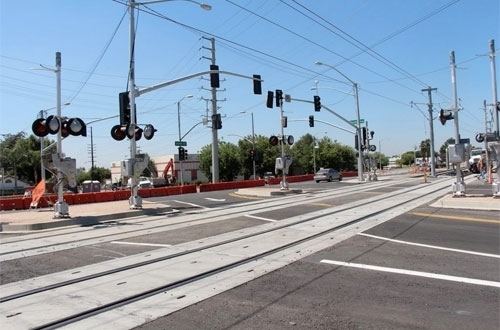 | ||
Opened March 5, 2016 (Phase 2A) Line length 11.5 mi (18.5 km) (Phase 2A) Terminis | ||
The Foothill Gold Line Extension (also known as the Gold Line Foothill Extension) is an extension of the Metro Gold Line light rail corridor from its former terminus in Pasadena, California, east through the "Foothill Cities" of Los Angeles County into San Bernardino County. The plan is being implemented as two separate mass-transit projects, known as Phase 2A (Pasadena to Azusa) and Phase 2B (Azusa to Montclair). Phase 2A was completed, while Phase 2B is in the planning stages and is currently not funded through construction. The corridor extension will be a part of the Los Angeles County Metro Rail System, and when completed will be served by the Metro Gold Line. The Foothill Gold Line is being planned and implemented by the Gold Line Foothill Extension Construction Authority.
Contents
- La metro gold line foothill extension grand opening go metro
- Route
- Initial environmental review
- Phase 2A to Azusa
- Station listing
- Status
- Budget
- Preconstruction activities
- Phase 2B to Montclair
- Proposed station listing
- References
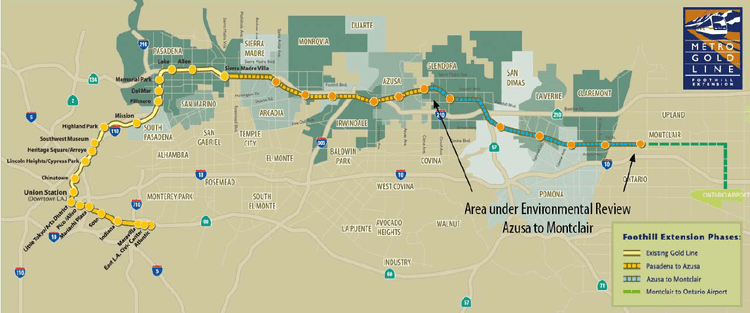
In addition to enhancing mobility in one of the most congested metropolitan areas in the United States, the 23.9-mile project (38.5 km) is seen as an economic catalyst for the region, generating 6,900 jobs during the construction phase and creating infill and transit-oriented development opportunities.
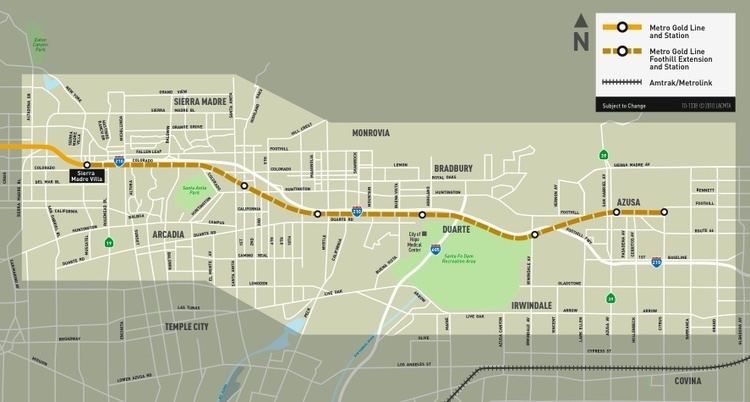
La metro gold line foothill extension grand opening go metro
Route
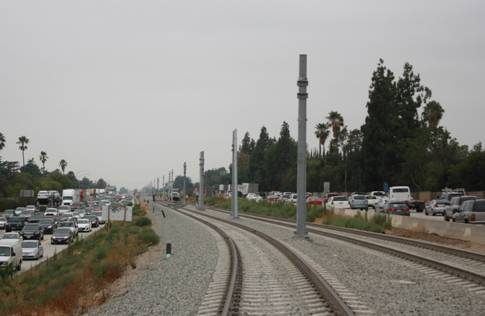
The entire 23.9-mile (38.5 km) route (Phase 2A and 2B) of the Foothill Gold Line follows the roadbed of the former Atchison, Topeka & Santa Fe Railway's Second Division through the Foothill Cities. These cities are located in the foothills south of the San Gabriel Mountains, in the northern San Gabriel and Pomona Valleys. Beginning at the existing Metro Gold Line station in East Pasadena, the route extends roughly east from there, ending in Montclair. The route parallels several major roads and highways, such as I-210 (Foothill Freeway), Huntington Drive, and Foothill Boulevard.
Initial environmental review
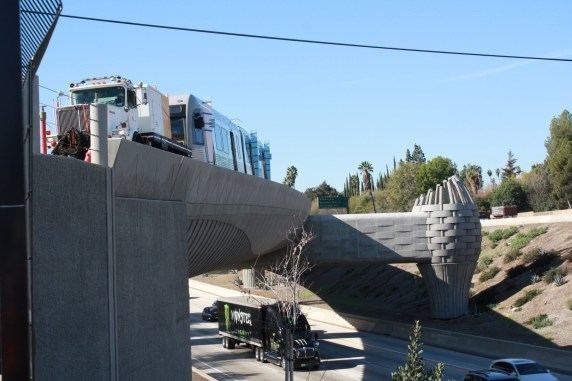
The Foothill Gold Line was originally conceived as "Phase 2" of the Metro Gold Line. (The route between Los Angeles and Pasadena is considered "Phase 1"). The Gold Line Construction Authority, which took over the Phase 1 project from Metro in 1999, is now coordinating the Phase 2 projects as well.
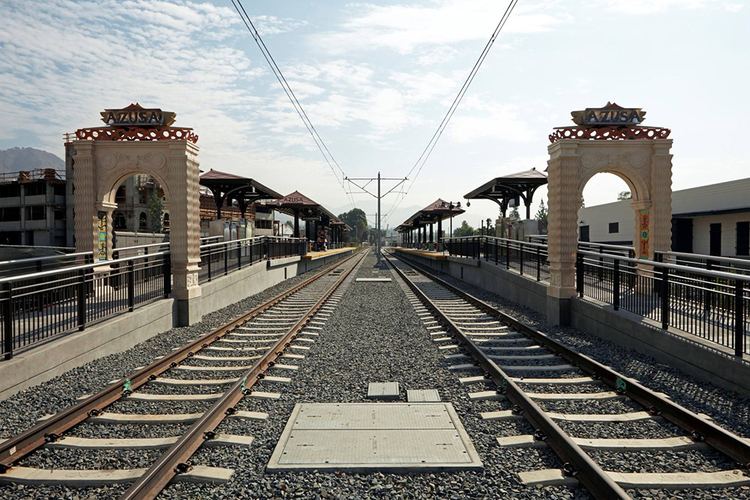
The Draft Environmental Impact Report (DEIR) for the Foothill Gold Line was completed in April 2006. Shortly thereafter, the process to complete the Final Environmental Impact Report (FEIR) study was begun.
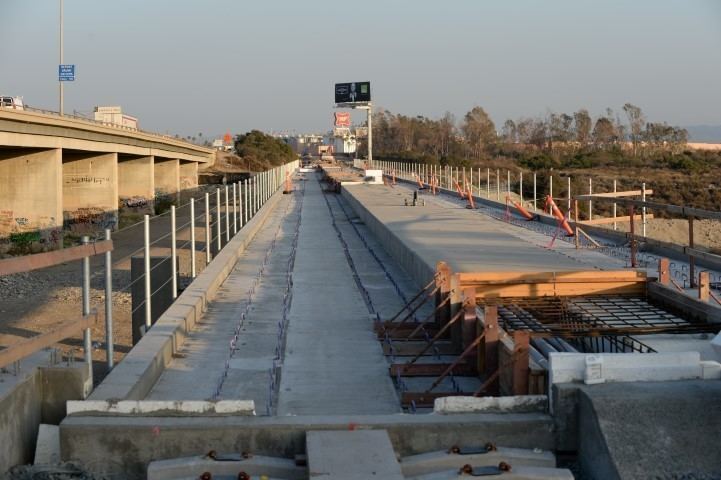
The FEIR studied two Build Alternatives: (1) an "LRT Full Build" alternative which would complete the entire extension to Montclair, and (2) an "LRT Build To Azusa" alternative, which would extend only to Azusa. (In addition, the FEIR studied a "no build" alternative and a "Transportation Management System" alternative, as required by law.)
On February 28, 2007, the Construction Authority Board certified the Final EIR and decided to complete the "LRT Build to Azusa" alternative. A Supplemental Environmental Impact Report (SEIR) was prepared by the Construction Authority and published on 23 September 2010. The main purpose of the SEIR was to study relocation of the Maintenance and Operations (M&O) Facility from Irwindale to Monrovia. In addition, the SEIR study looked at other updates to the project, including new/relocated parking structures and bridges, as well as a redesigned crossing at Mountain Avenue. The Construction Authority Board certified the SEIR on January 18, 2011.
For Phase 2B (Azusa to Montclair), the Final EIR was certified by the Authority Board in March 2013.
Phase 2A to Azusa
In October 2009, the Metro Board unanimously voted to include the Foothill Gold Line in its long-range plan, and approved funding for the construction and operation of Phase 2A.
The entire route is 11.5-mile (18.5 km) long and is expected to take approximately 17.2 minutes to traverse. The Phase 2A route begins at the existing Sierra Madre Villa station in East Pasadena, in the median of the I-210 freeway. From there, the route follows I-210 east to Arcadia, where just west of Santa Anita Avenue, the route exits the freeway and transitions to grade. The route then follows a southeastward route through Arcadia, across Huntington Drive to Duarte Road. The route then continues east along the north side of Duarte Rd through Monrovia and Duarte. From Duarte, the route closely parallels I-210, along the freeway's south side, as it crosses I-605 and the San Gabriel River into Irwindale. Next, the route crosses back north over I-210 and Foothill Boulevard into Downtown Azusa. Finally, the route finishes its eastward journey through Azusa, terminating at Citrus Avenue, adjacent to Azusa Pacific University and Citrus College.
Station listing
The alignment will have six new stations: Arcadia, Monrovia, Duarte/City of Hope, Irwindale, Azusa Downtown, and APU/Citrus College.
The Phase 2A will exit I-210 in Arcadia. In the past, a steel railroad bridge transitioned the right-of-way to grade. This bridge was removed by Caltrans, which deemed the structure unsafe following the 1994 Northridge earthquake. The Phase 2A project constructed a new, fully functioning light rail bridge, known as the "Gold Line Bridge". The bridge, designed by Minnesota artist Andrew Leicester, was unveiled in December 2012. Leicester was chosen from 17 others in a competitive process. The artist worked with L.A. design consultant AECOM as well as the bridge's builder, Skanska USA, on the final design and construction. The woven-basket look of the bridge's support columns emulate the famed woven baskets of the native Gabrielino/Tongva of the San Gabriel Valley while the underbelly of the bridge is supposed to evoke a Western diamondback rattlesnake.
Phase 2A also includes the new Maintenance and Operations (M&O) Facility in the city of Monrovia. The M&O facility will be used for servicing, cleaning, painting and storing light rail vehicles for Metro's growing fleet. It will have a total storage capacity of 84 vehicles. Originally planned for Irwindale, it is now located on a 27-acre (11 ha) site in Monrovia.
Status
The Foothill Gold Line from Pasadena to Azusa (Phase 2A) broke ground on June 26, 2010. Construction began the following summer and was completed in September 2015. Metro is performing safety testing with a projected opening in spring 2016.
The project was completed under four design-build-manage contracts. In February 2009, Metro commissioned Hill International to provide program management and construction management services. The Construction Authority Board awarded Skanska USA the contract to design and build the Gold Line Bridge in June 2010. Construction began in July 2011 and was completed in December 2012.
In July 2011, Foothill Transit Constructors, a Kiewit Parsons Joint Venture, was awarded the contract to design and build the Pasadena to Azusa “alignment” (including the stations, track, crossings, bridges and other improvements). The third design-build contract was awarded in February 2013 to Webcor Builders for the intermodal parking facilities and enhancements.
Once the project broke ground artists were made part of the projects three design-build teams, Kiewit and Parsons, Skanska and AECOM and Webcor. The project's nine experienced and professional artist - Michael Davis, Cha-Rie Tang, Andrea Myklebust & Stanton Gray Sears, Robin Brailsford, Jose Antonio Aguirre, Lynn Goodpasture, Christie Beniston and Andrew Leicester - found distinct ways to incorporate artwork that will leave enduring impressions on future riders.
In July 2014, Foothill Gold Line reported that the Pasadena to Azusa phase was nearly 75 percent complete. The project remained on budget and on time, and they were able to anticipate revenue service beginning in early 2016.
The operations and maintenance facility in Monrovia was completed May 23, 2015. The line opened for service in March 2016, but was immediately disrupted by a truck accident melting the wires between Allen and Arcadia stations.
Budget
The original project budget for Phase 2A is $690 million. This includes not only construction, but also purchase of vehicles, financing, administrative costs, mitigation, and other costs. The original construction budget is $485 million, which breaks down as follows:
In March 2011, the Construction Authority requested an $45 million increase in total budget, to $735 million, to reflect updated cost estimates.
Preconstruction activities
In March 2010, Metro and the Construction Authority signed Master Cooperative and Funding Agreements for Phase 2A. These documents spell out the mechanisms for transfer of funds from Metro to the Construction Authority. The terms of cooperation and funding were the subject of intense negotiation for several months.
Per the agreements, the Construction Authority would not receive construction funds until the following two conditions were met: that the Construction Authority had completed negotiations with BNSF over use of the right-of-way (ROW), and the Construction Authority had completed the SEIR and purchase at least half of the property to be used for the M&O facility. The agreements also specified that Metro will operate service over the line when it is completed.
In April 2011, the Construction Authority completed its agreement with BNSF, which agreed to abandon their use of the right-of-way west of the San Gabriel River. BNSF, which currently uses the right-of-way east of the San Gabriel River for light freight traffic, will continue to do so within the existing right-of-way. As part of the Phase 2A project, the freight track will be relocated within the right-of-way.
In July 2011, the Authority completed the second requirement, reaching agreement with the City of Monrovia for purchase of a city-owned site for the M&O facility. In addition, the Authority selected a joint venture of Kiewit Corporation and Parsons Corporation as the design build contractor.
In December 2011, the final BNSF train to traverse track west of Irwindale was operated. This move was the annual City of Hope Christmas train sponsored by BNSF. The tracks are now spiked with a flag and bumper at the San Gabriel River bridge and are now pending removal. Thus the entire section of track between the river bridge and end-of-track in Arcadia is now officially out of service. It is not known if BNSF will resume their annual Christmas trains upon completion of the Gold Line. Given that this is a once a year operation, the construction of an additional mile or two of track for this purpose would probably not be considered practical or cost effective. Thus, the future of the Christmas trains appears to be in doubt.
Phase 2B to Montclair
"Phase 2B" is the project to extend the Gold Line from the Phase 2A terminus in Azusa east to Montclair.
Proposed station listing
Phase 2B is 12.6 miles (20.3 km) long and will take approximately 17.9 minutes to traverse. The alignment will have six new metro stations: Glendora; San Dimas; La Verne; Pomona, at Pomona Metrolink with a connection to San Bernardino Line; Claremont, at Claremont Metrolink with a connection to San Bernardino Line; and Montclair, at Montclair Transcenter with a connection to San Bernardino Line and Foothill Transit Silver Streak.
Foothill Gold Line expects 17,800 riders by 2035.
Status
Planning for the Foothill Gold Line Phase 2B (Azusa to Montclair) began in 2003, and significant work has been completed for the segment. The Final EIR for the project was certified by the Construction Authority board in March 2013, and advanced conceptual engineering began in 2014. This two-year process will advance design for the project to a point where it will be ready for a design-build procurement.
Although funding has yet to be determined for this phase of the Foothill Gold Line, Los Angeles Mayor Eric Garcetti, who also serves as chairman of the County’s Metropolitan Transportation Authority, said in July that he would work to find funding for the project.
